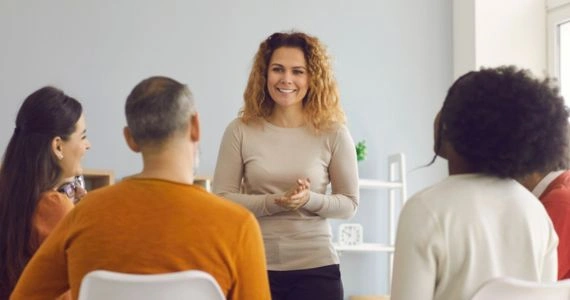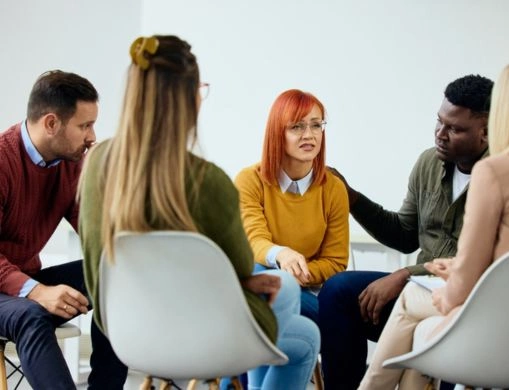Co-Occurring Disorders Group Activities
Our Group Therapy Activities for Co-Occurring Disorder Treatment
Table of Contents
Treatment programs for co-occurring disorders, the presence of both a substance use disorder treatment and a second mental health disorder, require individual therapy and working with peers in a group setting.
The Changes Healing Center team provides a supportive environment and targeted treatment modalities to address the mental health issues and substance abuse simultaneously. The structured environment of our Joint Commission-accredited treatment center in Phoenix, Arizona, takes a holistic approach to treatment to ensure each client’s overall well-being and lasting recovery.
Group therapy is a practical tool in treating dual-diagnosis clients and gives them the support system they need while learning about managing co-occurring disorders.
Prevalence of Dual Diagnosis in Addiction Recovery
The Substance Abuse and Mental Health Services Administration (SAMHSA) has reported that around 9.2 million Americans aged twelve and up have a mental illness along with a substance use disorder diagnosis.
An example of a dual diagnosis, or co-occurring disorders, is a person who struggles with major depressive disorder abusing stimulants to “up” their mood. The effects of the stimulants are fleeting, leading them to take higher doses more often and eventually become addicted.
Why Treating Co-occurring Disorders Is Necessary for the Recovery Journey
As mental health treatment providers, we know that the only successful pathway to recovery is to treat both conditions simultaneously, developing strategies to suit the needs of every client. In almost every case, that includes:
- Psychotherapy
- Behavioral therapies
- Reducing stress strategies
- Teaching appropriate coping strategies for triggers of substance abuse
- Relapse prevention strategies
We address these in individual therapy or a family or support group setting.
Group Therapy Provides Emotional Support and Healing
An integrated treatment process for co-occurring disorders, including medication management, individual psychotherapy, and peer support systems, contributes to a more effective recovery journey. Group members receive:
- Peer accountability
- Skill-building activities in real time
- Opportunities to practice healthy behaviors
- A sense of community and purpose
Group therapy sessions give people struggling with mental health conditions a place where they feel accepted and supported. In every case, the group leader will encourage active participation, including group discussions, to build a supportive community.
Process Groups
In process groups, member explore their emotions in the moment through their interactions with other group members. The sessions explore a broad topic instead of a set of rules, encouraging clients to explore their emotions and thoughts organically. Process group members support each other, give and receive feedback, and build healthy relationships. The process group setting is helpful for co-occurring disorder clients because they provide a safe space for mutual support among members.
Psychoeducational Support Groups
Psychoeducational support groups offer a more structured, supportive environment. They give clients a place for personal growth. In these sessions, they learn about their recovery and mental illness, with a goal of learning how to manage their well-being for a lifetime. The format covers topics like relapse prevention, how to manage stress, avoiding triggers, and coping strategies. They work on the specific tools of recovery instead of managing emotions.
12 Effective Co-Occurring Disorders Group Activities
Here are twelve evidence-based support group types that can help people make significant gains in addressing their mental health issues, including substance use disorders. Keep reading to learn some of the strategies and activities used in group therapy to build supportive relationships:
1 – Communication Skills Training (Group Discussions)
Communication skills are a must for continued personal growth after a treatment program. In this setting, group members support each other by practicing these in a group setting:
- How to express their feelings clearly and appropriately
- Set boundaries (practicing with other fellow group members)
- Listening to others without reacting
Some of the group activities they may engage in to accomplish these include these:
- Practicing “I feel” statements in pairs of small groups
- Role-playing conflict resolution strategies
- Participating in active listening exercises
- Group discussions on healthy versus unhealthy communication
These group activities play an enormous role in helping the person struggling with substance use maintain recovery after program graduation.
2 – Relapse Prevention Techniques Group
Leaving the safety of a treatment center isn’t the end of a struggle – it is the starting point of a new life of sobriety. But it takes commitment to staying clean and sober for the rest of the person’s life. Relapse prevention group members learn how to:
- Identify their substance use disorder triggers
- Avoid slip-ups and protect their sobriety
The National Institute on Drug Abuse agrees that group therapy activities are essential for a successful recovery process:
…Participation in group therapy and other peer support programs during and following treatment can help maintain abstinence. – NIDA
The activities often used in this supportive group environment are the following:
- Trigger mapping worksheets
- Group members assisting each other with personal relapse prevention planning
- Viewing videos of real-life relapses and discussing how they could have been handled better
- Mapping out mutual support groups in the community (AA, NA, SMART Recovery)
This supportive group setting helps each member focus on their own recovery needs while supporting recovery among group members.
3 – Peer Pressure and Healthy Relationships Groups

Exploring how to manage peer pressure and be assertive enough to avoid future use is an important sobriety tool. Clients who have a history of trauma, co-dependent relationships, or boundary-setting issues benefit from active participation in group activities that target their needs. The following are some of the group activities they may experience can include:
- Role playing saying “no” – firmly but politely
- Recognizing manipulative behaviors
- Group storytelling about times they’ve given in to others and how they can change it in the future
- Mastering assertive vs. aggressive responses with other group members
A specially trained group leader will teach them to protect their mental health and emotional regulation by becoming more assertive.
4 – Exploring the Inner Child/Childhood Self Group
Clients with identity struggles or traumatic childhoods may benefit from revisiting their childhood self in a safe environment.
The group provides emotional support as they complete these activities within the safe support system:
- Write letters to their younger self and read them
- Create collages or paintings that explore their unmet childhood needs
- Guided inner-child meditation
- Group discussions about what they might say to their 10-year-old self
These activities help build self-compassion and address underlying emotional wounds that contribute to substance use.
5 – Healthy Habits and Lifestyle Groups
Healthy habits are necessary for managing symptoms of co-occurring disorders. Physical fitness and mental health disorders share a close connection, making self-care strategies a must for long-term sobriety.
Recovery group topics usually focus on some universal self-care activities while still allowing group members to develop the best coping strategies for themselves:
- Sharing and discussing sleep tracker worksheets
- Meal planning and nutrition group educational activities
- Scheduling daily exercise or physical fitness (walking or yoga are CHC client favorites!)
- Sharing the positive aspects of their day with others in the group
- Completing “How to Manage Stress” worksheets and learning about the impact of stress on mental health conditions and physical well-being.
Clients in these groups start to feel better as they recover from drug or alcohol abuse physically and mentally.
6 – Interpersonal Skills Group

Learning better interpersonal skills helps clients build a support network after leaving treatment. It’s ideal for people who have dysfunctional relationships or who need to build empathy. The group leader is responsible for encouraging engagement and then gently guides group members through any roadblocks during these group therapy activities:
- Group gratitude sharing
- Empathy exercises – “Walk in my Shoes”
- Work with other group members to practice giving and receiving feedback
- Identifying red flags in relationships and learning to avoid them
These group therapy sessions help build emotional regulation and the relationship skills clients need for ongoing improvements in mental health.
7 – Anger Management Skills Group
Clients in anger management groups explore the root causes of their anger issues, which are common in mood disorders and personality disorders. They also start understanding their early warning signs and learn the coping skills to avoid outbursts without substance abuse or aggressive behaviors.
Some group activities that help with regulating anger include:
- Keeping trigger tracking journals and sharing entries with peers
- Body-mapping anger to understand where the tension builds
- Discussions based on cognitive reframing or challenging the unhelpful thoughts
- Brainstorming self-care tools to reduce anger
- Practicing deep breathing or progressive muscle relaxation to release the angry feelings
Group therapy is a good place for client to understand how their substance use disorder and emotional dysregulation share a close connection. They also begin to see how controlling outbursts is fundamental in managing co-occurring disorders.
8 – Art Therapy Groups
Art therapy gives clients a safe environment to explore their thoughts and feelings without words. These group activities help clients struggling with trauma, anxiety, or mood disorders express their relationship with substance abuse:
- Mask-making activities – “What I Show the World versus What I Hide”
- Painting their emotions using color
- Making collages based on specific themes – “My Recovery Journey” or “What Healing Looks Like to Me”
- Drawing from creative prompts, such as “Draw Your Safe Place” or “What Addiction Recovery Means to Me”
Clients use this group therapy space to process their emotions, lower anxiety, and become more self-aware. It’s a perfect setting for those not ready – or unwilling – to express their emotions verbally.
9 – Coping Strategies Groups

Recovering from substance use meant learning to identify the triggers to drug use: stress, anxiety, boredom, or emotional discomfort. Then, they must learn the coping skills to replace the old habits to manage them (drug or alcohol use) with healthy habits. A few group activities that can address these are:
- Brainstorming sessions – “My personal Coping Toolbox”
- Practicing grounding techniques, like the 5-4-3-2-1 method or deep breathing
- Completing SMART Recovery worksheets as a team
- Role playing scenarios – “What Should I Do Instead?” & “Playing the Tape Through“
- Sharing weekly wins and what’s worked versus what was less successful
These group activities help build resilience. Clients also learn to respond to stressful situations or triggers with intent rather than impulsively.
10 – Movement and Dance Group Therapy Activities
This group therapy uses dance and movement, such as gentle stretching, to help clients lower their stress levels, process emotions, and reconnect with their healing bodies. It’s invaluable for people with anxiety, depression, or PTSD. Dance and movement group activities include the following:
- Guided body awareness exercises
- Movement-based storytelling – “Move How You Feel Today” or “How Does Your Trauma Feel?”
- Dancing to express joy and gratitude
- “Shake it out” movement sessions to clear out stored tension or overwhelming feelings
- Group reflections to discuss how it felt to dance and move
Dance is one of the most active group therapy methods. It supports healthy emotional expression and helps clients show how they feel when they don’t feel up for a discussion of their feelings.
11 – Mindfulness and Meditation Groups
Mindfulness group therapy shows clients how to stay present, observe their thoughts objectively, and regulate their emotions. It combines mindfulness practices and breathwork, which can help regulate anxiety, cravings, and emotional overwhelm. Expect some of these highly effective group therapy activities:
- Guided meditations – body scanning, breathing awareness, loving-kindness
- Mindful journaling after meditation
- Using breathwork to overcome distress or cravings for substance use
- Group discussion of how group members felt during the stillness of meditation
The self-awareness gained during meditation and mindfulness group therapy helps clients learn to manage their co-occurring disorders.
12 – Storytelling and Narrative Therapy Support Group

Some clients are natural storytellers who benefit from telling others about their experiences with substance abuse. Storytelling – narrative therapy – can also help them reframe a painful past and really start to “own” their healing process. It’s helpful for those whose painful childhoods are the heart of their mental health issues. Some activities that may be very helpful in narrative and storytelling recovery groups are these:
- Writing and then reading aloud survival stories
- Sharing timelines of moments of change or self-growth with the group members
- Discussions of important moments on the recovery journey with others
- Sharing a painful story, then rewriting it with a better ending to showcase resilience and growth
The trained group leader keeps the recovery process on track and ensures all group members can share their stories. These particular group activities can become lively without proper guidance. Still, it’s a great tool for more verbally inclined people.
Does Health Insurance Cover Co-Occurring Disorders Group Activities?
Any insurance company that offers national Health Insurance Marketplace plans on the Affordable Care Act (ACA) website must provide mental health coverage. This mandate ensures that those struggling with mental illnesses or substance use get the care they need.
Generally, any treatment deemed medically necessary by a qualified mental health professional will be covered. That can mean everything from medical detox to medication-assisted treatment to individual and group therapy activities.
However, insurance companies have successfully found excuses to avoid covering mental health conditions for decades.
Instead of calling your insurance company, please call Changes Healing Center. We’ll review your plan and call them on your behalf, ensuring you receive the treatment you deserve. Once we have obtained all the coverage information, we will reconnect with you and share our findings.
Our goal when we reach out to the insurer is to help you receive the maximum benefits with the lowest costs out of your own pocket.
Get Effective Care for Co-Occurring Disorders at Changes
The treatment providers at Changes Healing Center have the experience and knowledge to address both mental health disorders – the substance use disorder and underlying mental health conditions – effectively. Our goal is always to make long-lasting changes and support ongoing sobriety.
Are you ready for recovery and personal growth? Call us today – it’s free and confidential.

